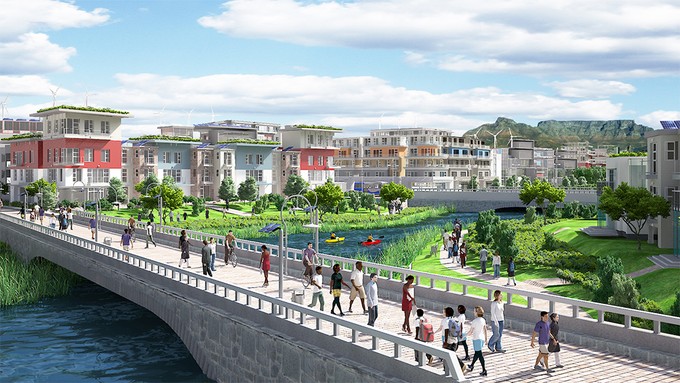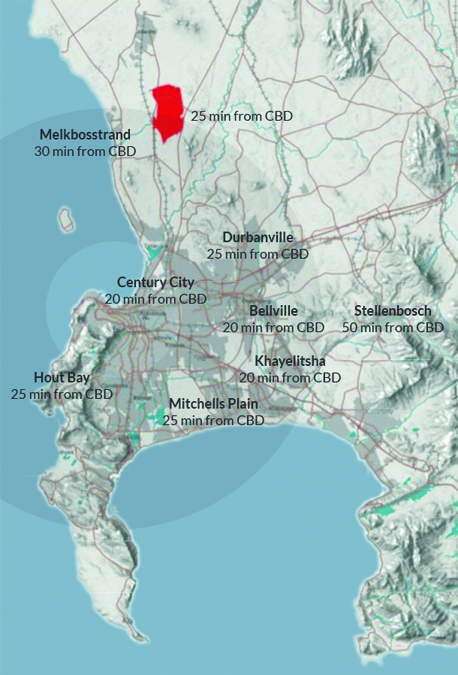
Artist’s impression of the proposed Wescape city. Image from Wescape website
31 May 2016
The City of Cape Town has approved the creation of a new city of 800,000 people in 200,000 homes, 20 kilometres from Cape Town up the west coast. But many questions about the controversial new development remain unanswered. In the first in a three part series, GroundUp asks: will Wescape succeed?
Read part two: Who will finance the new city?
Read part three: 800,000 people in Koeberg’s nuclear “red” zone?
The proposed Wescape development, more than 20km from the city centre, was first announced in 2012. In 2013, the developers overcame their first hurdle and secured the approval of the amendment by the Western Cape government to the urban edge.
Gita Goven, chairperson of communiTgrow, the developer of the project, says construction could begin as soon as next year, but “realistically”, 2019 or 2020 will be when “the spades hit the ground”.
CommuniTgrow is currently preparing an Environmental Impact Assessment (EIA) application, and securing finance for the project.
The vision for the privately funded Wescape is a city of about 800,000 people in 200,000 homes, over 400 schools and a university, over 90 community facilities. It is expected to offer about 300 000 jobs. The development is set to be carried out over 20 years.
For communiTgrow, Wescape makes sense against the backdrop of high levels of urbanisation, an enormous housing backlog and a spatially segregated city.
By 2031, communiTgrow (citing the City’s own data) expects Cape Town to have grown to 5.8 million people (up from 3.7 million in the 2011 census), although a UN estimate puts the number at 4.3 million people in 2030. CommuniTgrow also cites a 400,000 household housing backlog, a number that the City has also put forward. Again, this has been disputed, with other estimates being much lower, but the argument between those in favour and those against the Wescape development does not hinge on the figures, but on the choice of expansion rather than densification.
Goven agrees that densification is necessary. But she points to the high cost of purchasing land in the city centre and the lengthy application processes that are needed for each development in the city.
“I have been involved in low income developmental programmes and projects for 30 years, and in all that time it has been very difficult to unlock any of the larger sites in a way that is affordable to people who really need the housing,” she says.
The City’s own Built Environment Performance Plan 2014/15 emphasises the need to acquire large parcels of privately owned land in growth corridors to solve an impending shortage of public land.
Goven believes that it is “virtually impossible” to undo the “deeply spatially segregated structured city” that is Cape Town, and that coupled with this Cape Town has an “aging” and “stretched” infrastructure.
“So the extension of the urban edge into areas where the land prices are not so high offers the possibility to blend a range of income streams, so one can begin to deal with the vision for a city extension that actually has a better demographic mix, a cultural and social mix.”
Nancy Odendaal, who is senior lecturer in City Planning at the University of Cape Town and works with the African Centre for Cities, disagrees with Goven.
“I recognise that infill development and densification are difficult to achieve, but frankly, it can be done,” says Odendaal.
She says that she “understands the frustration” in making densification work but that she believes that “you cannot create a new city and put people in the middle of nowhere just because it is too difficult to do infill development”.
Gavin Silber, who is a researcher at Ndifuna Ukwazi and has a master’s degree in urban planning, is also adamant that densification of the city is the answer – not the development of Wescape.
“We should be looking at densifying the inner-city and surrounds and encouraging mixed-income integrated neighbourhoods by scaling up government subsidised rental stock, and strengthening regulation of the private market through policy instruments including rent controls and other mechanisms to protect tenants. Developments in more affluent areas should also be compelled to set a portion of new complexes aside for affordable housing. These are not pipe dreams – they are implemented widely across the world.”
Silber believes that an alternative to Wescape is to develop public land for housing on sites such as District Six, Culemborg and Youngsfield.
“Unfortunately, this land has historically been left undeveloped or sold to private developers, rather than being used to advance service delivery objectives as mandated by law.”
Wescape is set to be developed in phases and at the beginning it will be driven by the construction industry. “This is not a housing project, this is basically an economic development project,” states Goven – a statement that Odendaal rubbishes, saying that the project is indeed a housing project regardless of claims to the otherwise.
On Wescape’s website they explain that the “attendant opportunity is the subsequent clustering around the construction industry and the magnets / attractors which create a multiplier effect that in turn establishes a full array of sustainable economic activities over the life of the building project”.
Goven says in terms of this model, businesses and schools will be attracted to Wescape to meet the needs of those employed in construction.
“You actually begin to create the right relationship, the right market attractors and the magnets so that investors want to be there. In turn that grows the kind of demand level. So the things aggregate,” says Goven.
The aim is to start with a small community so that the first inhabitants of Wescape do not have to travel in from Cape Town for work.

Odendaal says that while communiTgrow’s vision has “an element of truth” in it, it contains major weaknesses. Many of the jobs created during construction are temporary jobs, she says; and there is doubt about how many will become permanent jobs. The economic argument is flawed, she says.
“You can’t build a city overnight,” says Odendaal, explaining that even with the best location and a large amount of funding and resources, creating a city is difficult.
Silber too questions this process.
“What types of industries will move there?” he asks. “Wescape’s architects have been very vague on this – yet the entire plan pivots on pulling this off successfully. It is incredibly difficult to build and sustain economic activity in a remote area.”
“Wescape is alluring to some public officials because it appears to be a silver bullet in addressing Cape Town’s housing backlog almost in its entirety. But most informed civil servants agree that Wescape would be disastrous.”
In researcher Liza Rose Cirolia’s paper on “(W)Escaping the challenges of the City: A critique of Cape Town’s proposed satellite town” she writes that a “complex set of factors” impact on industry and these “cannot be factored into a master planned design”.
“Past evidence from the case of Atlantis and more recent interviews with representatives of local industry in Cape Town suggest that industry does not follow cheap land.”
She argues that Wescape’s proposal is “deeply flawed” and tries to “escape rather than confront the operational, political and social challenges of the city”.
Rob McGaffin, who is a town planner and land economist, believes that the model that communiTgrow proposes where schools, businesses and industry will naturally develop in Wescape, is a “very simplistic” and “naïve model”.
“Humans don’t actually operate like that, we don’t use everything that is immediately available to us… We don’t live in self-contained communities,” he says.
Like Odendaal, he sees development within the city as the answer to the problems that Cape Town faces, but he says that these developments are often prevented by prospective neighbours who take on a “not in my backyard” approach to lower income developments in their neighbourhoods.
Wescape is designed for a range of housing and income brackets. A total of about 200,000 houses are to be built with about half as affordable housing.
Goven says there is “an open invitation” for people to move to Wescape. She says communiTgrow has spoken to people about Wescape and the desire for such a project has been “overwhelming”.
“People have actually been calling in and saying when can we sign up on the housing? That’s how excited they are.”
Silber wonders whether Goven herself would move to Wescape. “It is incredibly unlikely that people who can afford to live closer to the city would willingly choose to move 30km away from it. It is quite possible that Wescape will become the most isolated and segregated settlement in the country,” he says.
McGaffin asks how Wescape will attract middle class residents or those in the affordable housing market. In the end, he says, the residents of Wescape will be those who have no choice but to move there as that is where their subsidised homes will be.
The City of Cape Town declined to respond to questions from GroundUp, saying that the EIA had yet to be lodged.